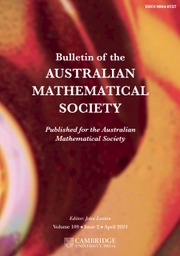No CrossRef data available.
Article contents
ON MATRICES ARISING IN FINITE FIELD HYPERGEOMETRIC FUNCTIONS
Published online by Cambridge University Press: 22 April 2024
Abstract
Lehmer [‘On certain character matrices’, Pacific J. Math. 6 (1956), 491–499, and ‘Power character matrices’, Pacific J. Math. 10 (1960), 895–907] defines four classes of matrices constructed from roots of unity for which the characteristic polynomials and the kth powers can be determined explicitly. We study a class of matrices which arise naturally in transformation formulae of finite field hypergeometric functions and whose entries are roots of unity and zeroes. We determine the characteristic polynomial, eigenvalues, eigenvectors and kth powers of these matrices. The eigenvalues are natural families of products of Jacobi sums.
MSC classification
Information
- Type
- Research Article
- Information
- Bulletin of the Australian Mathematical Society , Volume 110 , Issue 3 , December 2024 , pp. 421 - 426
- Copyright
- © The Author(s), 2024. Published by Cambridge University Press on behalf of Australian Mathematical Publishing Association Inc.
Footnotes
The first author was supported by JSPS KAKENHI Grant Number JP22KJ2477 and WISE program (MEXT) at Kyushu University. The second author thanks Ken Ono for providing research support with the Thomas Jefferson Fund and the NSF Grant (DMS-2002265 and DMS-2055118).


